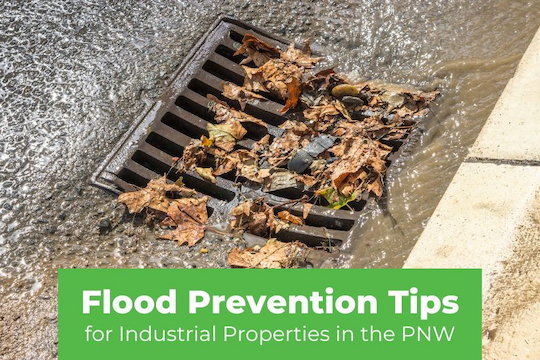Keeping hospital infrastructure for stormwater management in top operating shape is a critical mission for any healthcare campus. The smooth functioning of this and other systems ensures the well-being of patients and the successful operations of the facility, even under duress from extreme weather events.
Given the complexities of a hospital operation, stormwater management becomes an even more critical concern, as flooding and other issues can have even more disastrous outcomes. Hospitals must effectively manage their challenges, and maintaining their stormwater infrastructure is a vital piece of this puzzle.
What Is Hospital Stormwater Infrastructure?

The infrastructure used to manage stormwater for hospitals covers the physical systems, facilities, and stormwater system components designed to handle stormwater runoff that falls on hospital premises. The infrastructure typically has both engineered and natural components that work together to mitigate any adverse impacts of stormwater, including flooding, erosion, pollution, and contamination.
A hospital's system components may include catch basins, complex drainage systems, channels and pipes that convey water to different areas of the property or off the property into other systems or local bodies of water. Hospitals may have retention and detention facilities such as basins or ponds that temporarily store the excess runoff to keep it from overwhelming the drainage systems during heavy rainfall.
Some hospitals have integrated green infrastructure such as permeable pavement and green roofs to help provide water filtration and enhance stormwater quality. Systems may also include sediment basins to trap particles, oil and grease separators to protect against water pollution, and other features such as erosion control measures.
Special Challenges for Hospital Properties
Hospital properties have specific challenges in stormwater management procedures because of the critical operations that take place at the facility and the complexity of their infrastructure. One critical challenge involves maintaining the facility's essential medical services even if stormwater-related disruptions occur.
The system must also work to control hazardous waste runoff to prevent water pollution and address any potential for infection transmission from improperly handled medical waste by integrating proper drainage systems. Hospitals must be prepared to adhere to regulatory compliance regarding the quality and quantity of stormwater managed, patient safety during weather extremes and incorporating green infrastructure within the limited and often crowded space of a hospital campus.
Hospitals must be prepared to deal with emergency preparedness challenges in case of extreme weather events, which entails the ability to operate continuously without disruption. In addition, healthcare facilities must add upgrades to an aging stormwater system to their list of challenges. Hospitals must strategize using a multidisciplinary approach that balances health care, engineering, regulatory compliance, and public perception to ensure that stormwater is managed effectively and in alignment with the facility's critical functions and environmental responsibilities.
8 Ways to Maintain Hospital Stormwater Infrastructure
As part of their stormwater management plan, hospitals must have routine maintenance and inspection to ensure their system remains at peak operating capacity at all times. The following discusses eight essential ways to maintain hospital infrastructure for stormwater management. These principles consider the unique challenges of managing stormwater in a critical hospital environment.

1) Develop an Emergency Response Plan: Assemble a comprehensive plan to respond to emergencies that specifically address stormwater-related disruptions. The plan should be structured to ensure the safety of patients, provide continuity of care, and protect staff's well-being during events that involve extreme weather.
2) Integrate Green Infrastructure: Green solutions for managing stormwater include permeable pavements and rain gardens that can handle the stormwater where it falls rather than conveying it somewhere else. Green infrastructure solutions reduce the volume of runoff, and their natural filtration enhances water quality while the greener environment contributes to creating a healing outdoor environment for patients.
3) Take Measures to Control Infection: Hospitals last design their stormwater systems to prevent the spread of infections. Hospitals must ensure they have proper drainage and disposal methods for medical wastewater And maintain their stormwater systems properly to safeguard patients, staff, and the environment.
4) Managing Hazardous Waste: Another of the essential ways to maintain hospital infrastructure is implementing stringent protocols used to manage hazardous waste and prevent it from being discharged into stormwater systems. This critical step can mitigate any additional risk of pollution and ensure regulatory compliance.
5) Regulatory Compliance: Hospitals must stay updated with stormwater regulations that pertain specifically to healthcare facilities. These rules can include federal, state and local guidelines, and hospitals must remain compliant to ensure environmentally responsive practices and avoid assessing potential fines.
6) Regular Maintenance Routines: Like other property types, hospitals must have regular, scheduled maintenance routines to keep their stormwater system in good operating condition. Routine maintenance typically addresses catch basins, retention ponds and drainage pipes, among other system components. Keeping these devices cleaned out and in good repair prevents potential flooding, erosion and water contamination.
7) Advanced System Technology: Hospital stormwater systems can benefit from using advanced technology as one of the ways to maintain hospital infrastructure. Systems might be equipped with sensors and other real-time performance monitoring components. These types of technology provide early warnings, which allows a hospital to respond quickly to changing and potentially dangerous conditions.

8) Training and Team Collaboration: Healthcare and engineering teams can provide better infrastructure care and maintenance when they work as a united team. Conducting regular training can raise awareness and educate on stormwater management issues and protocols, infection control measures, and emergency response procedures.
Creating a Safer, More Sustainable Healthcare Environment
Maintaining hospital stormwater infrastructure is one of the keys to ensuring that the healthcare environment remains safe under all conditions. Additionally, prioritizing sustainability means that the hospital will remain safe while also protecting the environment.
As hospitals strive to maintain top-notch patient care, it is essential to recognize the importance of catch basin maintenance as one of the critical components of a well-functioning hospital stormwater infrastructure. CatchAll Environmental provides critical maintenance and repair services for stormwater infrastructure. Our expert team can provide assistance with regulatory issues, system upgrades and much more. Contact Catchall today to see how we can help!













